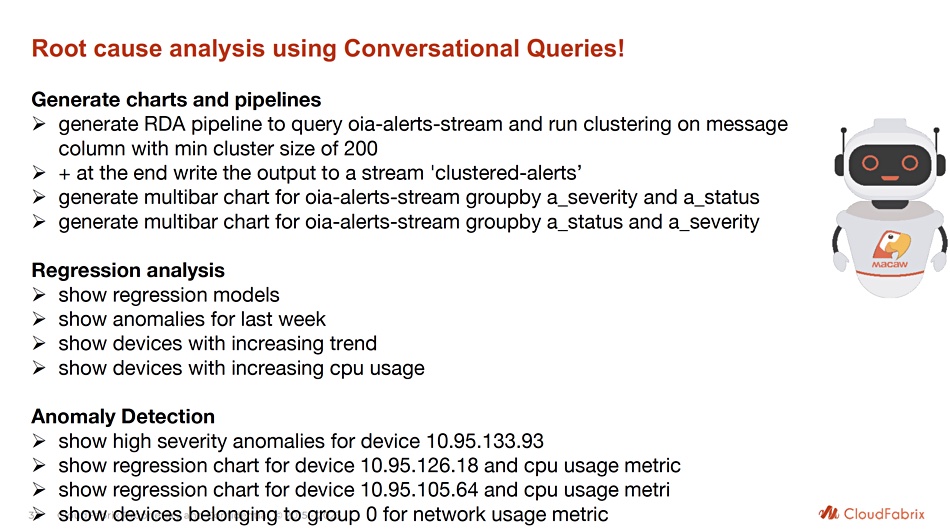Startup CloudFabrix is integrating its Macaw Gen AI assistant into incident management and root cause analysis. But will smart admin chatbots be any more successful than Tintri’s failed speechbot?
Macaw, introduced in June 2023, enables conversational queries to look into CloudFabrix’s observability data fabric and get answers to system performance and characteristics questions. The system here being a complex business process – such as a telco’s infrastructure or an etailer’s IT componentry. Such systems are instrumented and element logs automatically passed through a Robotic Data Automation Fabric (RDAF) pipeline to upper level observability and AIOps services – Cisco’s Observability platform for example.
Tintri set up an AWS Alexa-powered speechbot in 2017, through which people could query the Tintri array system and look at its VMware-oriented storage constructs’ state and have VMs provisioned with storage. They received spoken output. (See video here.) Tintri crashed, nearly burned, and its assets were bought by DDN in 2018. The speechbot was a sideshow to this and completely overshadowed by it.

Traditionally, fixed or tick-list dashboard reports are generated for admins, but Macaw lets admins make conversational text queries and requests on the fly to investigate any particular situation. Examples were shown at a recent IT Press Tour which visited CloudFabrix in Pleasanton. Macaw was pitched as an integral part of CloudFabrix’s offering and available for operations, admin and exec staff. Unlike a typical dashboard, with a fixed hierarchy of menus, Macaw is open-ended – questions and requests get responses from a virtual concierge with full knowledge of all CloudFabrix processes and metadata about the customer’s process system stack. It democratizes observability and AIOps, according to CloudFabrix.
A slide listed text queries made to the incident management part of CloudFabrix’s system using the Macaw chatbot:

The last point requests a probable root cause for an incident to be provided, and CloudFabrix CMO put up a slide showing Macaw helping with this:

These allow admins to dive progressively deeper into an incident to diagnose its underlying cause, discover it and then set up a fix.
Noting that CloudFabrix’s Macaw is based in input text rather than speech, will Macaw be any more successful than Tintri’s speechbot?
First, we can say that Tintri’s speechbot was introduced when its creator was starting down the slippery failure slope and that obscured the bot’s capabilities.
Second, this was six years before the discovery that LLM-powered ChatGPT was astonishingly powerful as a text input and response chatbot – much smarter and more capable than 2017-era Alexa.
Third, and finally, speech input to a system has to be transcribed into text before it can be analyzed and processed by a smart chatbot – and speech is messy. Or, as we might actually say: “Er, speech is uh, you know, like, messy.”
Even today, wth LLM help, speech input to the Perplexity AI is pronunciation-dependent. A request to “Tell me about Vcinity” received the response: “Vic.ai is an artificial intelligence (AI) software company …” which is quite useless.
With text input you can see the words you type and correct mis-spellings so that you send the smart chatbot a well-formed and correctly spelled question. Tintri’s Alexa speechbot would probably have failed – even if Tintri had not crashed – for these reasons. We can say, though, that Tintri was a pioneer years ahead of its time in seeing a role for chatbots in system adminstration. Then, Alexa was dumb. Now, Macaw is smart. Vive la difference.
Skilled smart chatbots like the CloudFabrix system-aware Macaw will enable low-level and medium skilled admins to be as effective, possibly, as skilled admins. And that is a productivity gain worth having.








